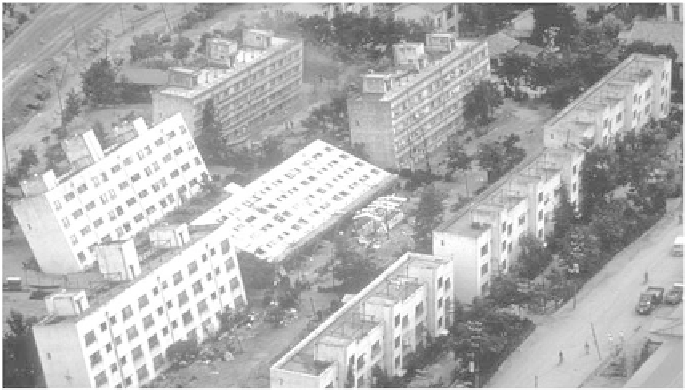Environmental Engineering Reference
In-Depth Information
to the overburden confining pressures, the effective stress between soil particles becomes
zero, the sand completely loses its shear strength, and enters a liquefied state.
Origin
: Wylie and Streeter (1976) hypothesized that the shearing motion of the soil
causes a slippage or sliding of soil grains, which weakens the soil skeleton temporarily
and causes the constrained modulus to be reduced. At the time of shear reversal, the par-
ticles do not slide, so the skeleton recovers much of its original strength, but in a slightly
consolidated form. The consolidation reduces the pore volume, thereby tending to
increase pore pressure and to reduce the effective stress in the soil skeleton. Since shear
modulus and maximum shear stress depend on effective stress, the horizontal shaking
causes a trend towards zero effective stress, and hence liquefaction. Drainage by percola-
tion tends to reduce pore-pressure rise and cause stabilization.
Ground response
: The phenomenon can occur in a surface deposit or in a buried stratum.
If it develops at depth, the excess hydrostatic pressures in the liquefied zone will dissipate
by upward water flow. A sufficiently large hydraulic gradient will induce a “quick” or liq-
uefied condition in the upper layers of the deposit. The result is manifested on the surface
by the formation of boils and mud spouts and the development of “quicksand” condi-
tions. As the ground surface liquefies and settles in an area with a high groundwater table,
the water will often flow from the fissures of the boils and flood the surface. Even if sur-
face liquefaction does not occur, subsurface liquefaction can result in a substantial reduc-
tion in the bearing capacity of the overlying layers.
Surface effects
can be significant as shown by occurrences in Alaska and Japan in 1964 and
Chile in 1960. Buildings settled and tilted (Figure 11.33), islands submerged, dry land became
large lakes, roads and other filled areas settled, differential movement occurred between
bridges and their approach fills, and trucks and other vehicles even sank into the ground.
Soft Cohesive Soils
Partial liquefaction
can be said to occur in soft cohesive soils. Longitudinal waves, because
of their characteristics of compression and dilation, induce pore-water pressures in satu-
rated clays. The seismically induced pore pressures reduce the shear strength of the soil,
and subsequently the bearing capacity, resulting in partial or total failure. Deformation in
FIGURE 11.33
Overturning of buildings during 1964 Niigata earthquake. (Photo from Internet:
www.nd.edu/
∼
quake/education/liquefaction/.)



